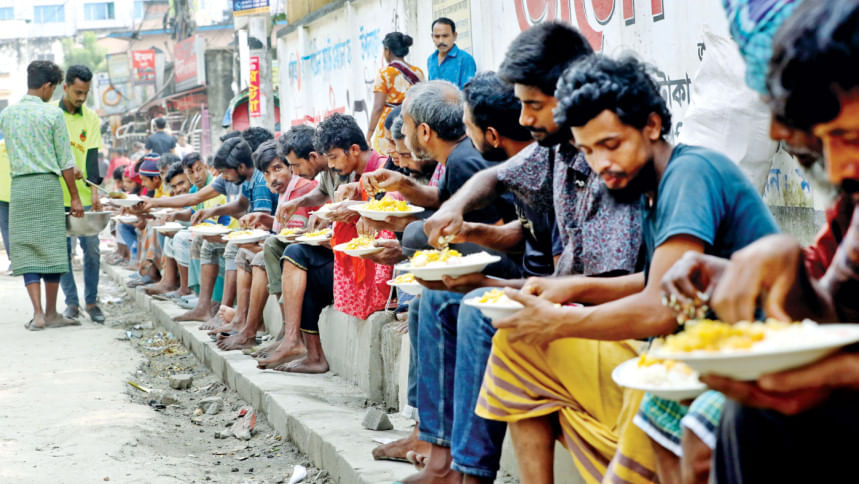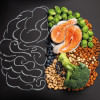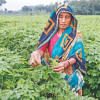Nutrition becomes luxury for the poor amid high prices

- Long queues form at subsidised food trucks
- High inflation erodes wages, deepens poverty
- Millions struggle with hunger, malnutrition rising
- Experts urge universal rationing, stronger safety-net
Rosy was waiting to buy some rice and wheat flour from a government-run truck in front of the Rayer Bazar Martyred Intellectuals Memorial. There were already 20 women in the queue, with more adding every minute, even though the sale was yet to begin.
The dealer, Harun ur Rashid, was expecting a food directorate official who would give him the nod to begin selling.
The truck sells essential food items at a cheaper rate under the open market sales (OMS) programme. For Rosy, who does not have any last name, this was the last option to get food as prices continue to spiral without any signs of cooling down.
"There is nothing at home to cook. I came out to buy some dry fish and get some flour from here," said the woman in her 40s.
Rosy lives with her son, who earns Tk 12,000 a month working at a sweets store. Over half the amount goes to clear house rent, leaving a meagre amount for them to spend on food and meet other necessities.
She used to clean offices and do other chores at a buying house on Elephant Road in Dhaka, earning Tk 200 a day. "But the buying house closed recently, and I haven't been able to find a job. We are now dependent on my son's income alone. This has put us in a tougher situation as prices are too high."
A farmer's daughter, growing up, Rosy was not familiar with the extremities of food scarcity. "I never imagined that one day I would have to wait in the queue of an OMS truck to buy food."
Across major cities, particularly in Dhaka, such stories have become common. From teenagers to elders, people now line up to buy subsidised items to survive. Quite often, stocks run out mid-queue. Desperate, some even run after the truck as it leaves; others pick up the leftovers from the street, videos and media reports show.
The long queues at OMS trucks depict a harsh reality as Bangladesh continues to struggle with high inflation, which stood at 10 percent in the fiscal year 2024-25 (FY25), up from 9.7 percent the previous year.
On the other hand, growth in wages of low-income individuals has remained below the inflation rate since May 2021, while the gap has narrowed in recent months.
The World Bank, in a recent report, said poverty rose to 21.2 percent in FY25 as weak growth and labour market stress eroded welfare. Three years ago, the national poverty rate was 18.7 percent. Extreme poverty went up, too, during this period.
It said total employment between 2023 and 2024 dropped by almost 20 lakh to reach 6.91 crore, and almost all sectors lost jobs, with services the hardest hit. Unemployment also rose to 3.7 percent, with many discouraged workers simply stopping looking for work, according to the WB's latest Bangladesh Development Update. Those with low-wage jobs were hit the hardest.
"Persistently high inflation eroded purchasing power across households, but the impact was sharpest for low-paid workers, whose real wages fell by 2 percent in FY25."
An August report by the Power and Participation Research Centre (PPRC) puts the poverty rate at roughly 28 percent.
The report stated that the ratio of the extremely poor population rose to 9.35 percent in 2025 from 5.6 percent three years ago. Apart from this, 18 percent of households that are just above the poverty line are at risk of falling below the line.
Amid the hardship, the poorest 40 percent of households had to resort to borrowing, increasing their net debts by 7 percent over the preceding six months, mainly for increased household consumption, it added.
Delwar Hossain, 25, a mason's assistant living in Kalikapur of the southern coastal district of Patuakhali, earns Tk 500-Tk 600 a day. But the income is irregular.
"After paying for food and transport costs, there's barely anything left," said the sole breadwinner for his five-member family. "I often borrow from neighbours or microcredit institutions to keep the family afloat. If I fall sick or can't work due to bad weather, things get worse."
"We survive on rice, lentils, and vegetables. Nutritious food is out of the question; we can't even afford enough rice to fill our stomachs," he added.
Eighteen-year-old Sagar, who lives with his mother at the Laukathi Ashrayan project in the same district, earns Tk 6,000 on average a month and faces a similar struggle.
"We mostly eat vegetables, and even eggs are too costly. Sometimes, at night, I fish in a small canal near our home. If I catch a few, that's our protein for the day. Buying fish or fruit from the market is unthinkable."
For Kuddus Hawlader, a 62-year-old small tailor in Patuakhali town, "meat has become a dream."
"We only get to eat it once a year during Eid-ul-Azha, when the rich share their sacrifices. Even broiler chicken is beyond our reach now. Before, I used to buy some once or twice a month for my children. But with the rising prices, I can't afford it anymore," he said on Tuesday, two days before World Food Day 2025, which is being observed across the globe today.
With the theme, 'Hand in hand for better food and a better future', the day calls for global collaboration in creating a peaceful, sustainable, prosperous, and food-secure future.
Marking the day, the Food and Agriculture Organization said that in some places, the severity of food insecurity is overwhelming. An estimated 673 million people are living with hunger.
Jahangir Alam, an agricultural economist, said food security is not yet ensured even though estimates show that the production of grains has grown nearly five times since the nation's independence in 1971. Bangladesh still has to import to meet its requirements.
"Access to food has reduced for many because of high food inflation in the last three to four years. As a result, poverty has increased," he said, adding that 31 percent of the population in Bangladesh is food insecure.
Food insecurity has been exacerbated by waste and loss of food. The South Asian country loses and wastes 34 percent of its available food, which accounts for 4 percent of its Gross Domestic Product, according to a WB paper presented at a seminar last month.
"Rich people waste a lot of food. We also see waste in restaurants," he said. "A lot is lost due to the absence of scientific storage and cold chain transport."
Anu Muhammad, former professor of economics at Jahangirnagar University, said access to food has not increased in pace with the spike in production.
At the same time, increased production has come at a cost. Production has increased through the use of pesticides and chemical fertilisers. "This makes the food unsafe. So, food security and safety have not been ensured even after the production increase."
Citing increased poverty, he said the government could play a bigger role in addressing this. "The government should introduce a universal rationing system.
"At present, food is sold through trucks, and we see people running behind the trucks to catch them. It is inhumane."


 For all latest news, follow The Daily Star's Google News channel.
For all latest news, follow The Daily Star's Google News channel. 








Comments